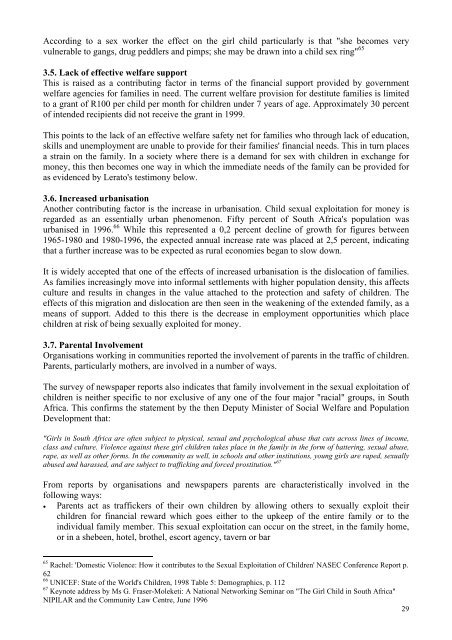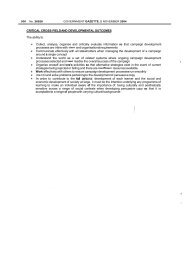The trafficking of children for purposes of sexual exploitation
The trafficking of children for purposes of sexual exploitation
The trafficking of children for purposes of sexual exploitation
You also want an ePaper? Increase the reach of your titles
YUMPU automatically turns print PDFs into web optimized ePapers that Google loves.
According to a sex worker the effect on the girl child particularly is that "she becomes very<br />
vulnerable to gangs, drug peddlers and pimps; she may be drawn into a child sex ring" 65<br />
3.5. Lack <strong>of</strong> effective welfare support<br />
This is raised as a contributing factor in terms <strong>of</strong> the financial support provided by government<br />
welfare agencies <strong>for</strong> families in need. <strong>The</strong> current welfare provision <strong>for</strong> destitute families is limited<br />
to a grant <strong>of</strong> R100 per child per month <strong>for</strong> <strong>children</strong> under 7 years <strong>of</strong> age. Approximately 30 percent<br />
<strong>of</strong> intended recipients did not receive the grant in 1999.<br />
This points to the lack <strong>of</strong> an effective welfare safety net <strong>for</strong> families who through lack <strong>of</strong> education,<br />
skills and unemployment are unable to provide <strong>for</strong> their families' financial needs. This in turn places<br />
a strain on the family. In a society where there is a demand <strong>for</strong> sex with <strong>children</strong> in exchange <strong>for</strong><br />
money, this then becomes one way in which the immediate needs <strong>of</strong> the family can be provided <strong>for</strong><br />
as evidenced by Lerato's testimony below.<br />
3.6. Increased urbanisation<br />
Another contributing factor is the increase in urbanisation. Child <strong>sexual</strong> <strong>exploitation</strong> <strong>for</strong> money is<br />
regarded as an essentially urban phenomenon. Fifty percent <strong>of</strong> South Africa's population was<br />
urbanised in 1996. 66 While this represented a 0,2 percent decline <strong>of</strong> growth <strong>for</strong> figures between<br />
1965-1980 and 1980-1996, the expected annual increase rate was placed at 2,5 percent, indicating<br />
that a further increase was to be expected as rural economies began to slow down.<br />
It is widely accepted that one <strong>of</strong> the effects <strong>of</strong> increased urbanisation is the dislocation <strong>of</strong> families.<br />
As families increasingly move into in<strong>for</strong>mal settlements with higher population density, this affects<br />
culture and results in changes in the value attached to the protection and safety <strong>of</strong> <strong>children</strong>. <strong>The</strong><br />
effects <strong>of</strong> this migration and dislocation are then seen in the weakening <strong>of</strong> the extended family, as a<br />
means <strong>of</strong> support. Added to this there is the decrease in employment opportunities which place<br />
<strong>children</strong> at risk <strong>of</strong> being <strong>sexual</strong>ly exploited <strong>for</strong> money.<br />
3.7. Parental Involvement<br />
Organisations working in communities reported the involvement <strong>of</strong> parents in the traffic <strong>of</strong> <strong>children</strong>.<br />
Parents, particularly mothers, are involved in a number <strong>of</strong> ways.<br />
<strong>The</strong> survey <strong>of</strong> newspaper reports also indicates that family involvement in the <strong>sexual</strong> <strong>exploitation</strong> <strong>of</strong><br />
<strong>children</strong> is neither specific to nor exclusive <strong>of</strong> any one <strong>of</strong> the four major "racial" groups, in South<br />
Africa. This confirms the statement by the then Deputy Minister <strong>of</strong> Social Welfare and Population<br />
Development that:<br />
"Girls in South Africa are <strong>of</strong>ten subject to physical, <strong>sexual</strong> and psychological abuse that cuts across lines <strong>of</strong> income,<br />
class and culture. Violence against these girl <strong>children</strong> takes place in the family in the <strong>for</strong>m <strong>of</strong> battering, <strong>sexual</strong> abuse,<br />
rape, as well as other <strong>for</strong>ms. In the community as well, in schools and other institutions, young girls are raped, <strong>sexual</strong>ly<br />
abused and harassed, and are subject to <strong>trafficking</strong> and <strong>for</strong>ced prostitution." 67<br />
From reports by organisations and newspapers parents are characteristically involved in the<br />
following ways:<br />
• Parents act as traffickers <strong>of</strong> their own <strong>children</strong> by allowing others to <strong>sexual</strong>ly exploit their<br />
<strong>children</strong> <strong>for</strong> financial reward which goes either to the upkeep <strong>of</strong> the entire family or to the<br />
individual family member. This <strong>sexual</strong> <strong>exploitation</strong> can occur on the street, in the family home,<br />
or in a shebeen, hotel, brothel, escort agency, tavern or bar<br />
65 Rachel: 'Domestic Violence: How it contributes to the Sexual Exploitation <strong>of</strong> Children' NASEC Conference Report p.<br />
62<br />
66 UNICEF: State <strong>of</strong> the World's Children, 1998 Table 5: Demographics, p. 112<br />
67 Keynote address by Ms G. Fraser-Moleketi: A National Networking Seminar on "<strong>The</strong> Girl Child in South Africa"<br />
NIPILAR and the Community Law Centre, June 1996<br />
29
















